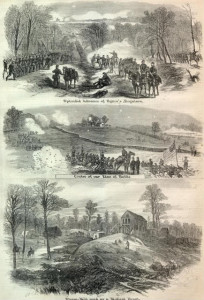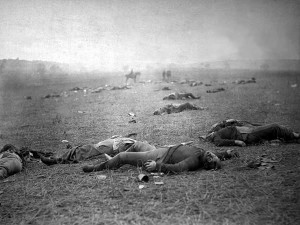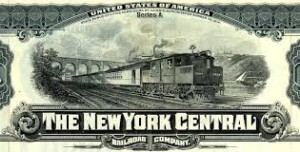The Rutters were involved in the railroad business for generations.
William Edward Rutter was my wife’s third great grandfather. He was involved in the transition between horse carriages and railroad carriages.
The Elmira Car Works was founded at Elmira, New York, in 1851 by William E. Rutter, as a car repair shop servicing the newly constructed New York & Erie Railroad. A year later it began to build cars.
Elmira Car Works’ founder, William E. Rutter (1812-1882), was born in Providence, Rhode Island, and had learned the trade of carpenter in Baltimore. (One source says he was an experienced carriage builder.) In the early 1830s he went to work for the Boston & Providence Railroad, and later became master mechanic on their Stonington line. He moved to Elmira only a little before opening his plant.
In 1848 he sold his plant to the Erie railroad, but stayed on as manager.
His sons were William Rutter (?-1854), Nathaniel Rutter (1841-1863) and James H. Rutter (1836-1885), from whom my wife is descended.
William Rutter died young. He had a heart attack on October 18, 1854 when he was responding to a fire with Young America Hose Company.
Nathaniel Rutter enlisted as a second lieutenant in the 107th New York Regiment, “Campbell Guards.” He rose to the rank of captain December 31, 1862, fought in the first battle of Antietam, was killed by a shell at the battle of Chancellorsville on May 1, 1863. He was twenty-two. Col Colbey described him as “a worthy and competent officer.”
The 107th New York
This regiment, known as the Campbell Guards, was recruited in the counties of Chemung, Schuyler and Steuben, rendezvoused at Elmira, and was there mustered into the U. S. service for three years, Aug. 13, 1862. It was a fine regiment, noted for its efficiency and discipline, the first regiment from the North organized under the second call, and the first to arrive at Washington, in acknowledgment of which it received a banner from the state and a personal visit from the president. It was raised by two patriotic members of the legislature, Robert B. Van Valkenburg, and Alexander S. Diven, who became colonel and lieutenant-colonel, respectively. It left the state on Aug. 13, 1862; was stationed in the defenses of Washington for a month; was then assigned to the 1st division (Williams), 12th corps (Mansfield), and fought its first battle at Antietam, where it was heavily engaged, losing 63 in killed, wounded and missing. The veteran Gen. Mansfield fell, mortally wounded at Antietam, and Gen. Henry W. Slocum succeeded to the command of the corps. The regiment was again heavily engaged at the disastrous battle of Chancellorsville, where the brunt of the fighting fell on the 3d and 12th corps, and lost in this action 83 killed, wounded and missing, among the killed being Capt. Nathaniel E. Rutter.
James H. Rutter was my wife’s great great grandfather. He was born February 3, 1836 in Lowell, Massachusetts. He studied at the Scholfield Business School and At the age of 18, in 1854, he started his career as a clerk in the fright office of the Erie Railroad. The next year he became chief clek in the freight office of the Williamsport and Elmira Railroad. In 1857, at the age of twenty-one, he became chief clerk in the Chicago freight office of the Michigan Central and Northern Indian Railroad. In 1858 he became freight agent of the Chicago and Milwaukee Railroad. In 1860 he was back in Elmira as the stationmaster of the Erie Railroad. In 1864 he became freight agent in Buffalo of the Erie Railroad, and in 1866 the assistant general freight agent.
While testifying about railroad rates, he impressed William H. Vanderbilt, who hired him in 1870 as the General Freight Agent of the New York Central with the salary of $15,000 a year ($250,000 in 2015 dollars). In 1877 he became a director of the New York Central, in 1880 Third Vice-President, and in 1883, at the age of forty-seven, President of the New York Central.
William Vanderbilt had been in poor health, (high blood pressure, mild stroke); he had sons, but knew that Rutter was more intelligent and competent.
Mark Twain was scheduled to meet Rutter in 1885 to interest him in investing in the printing telegraph and the typesetter that Twain hoped would make his fortune, but Rutter was ill with diabetes at his house in Irvington and died on June 27, 1885.
At the same time, unbeknownst to each other, his wife Sarah Pollack Rutter was dying of brain inflammation. She died the next day, June 28, 1885.
They were buried from St. Thomas Church in New York at the same service. They left several children. They named one Nathaniel, after his uncle who had died at Chancellorsville, and ever afterwards there have been Nathaniels in the family. Their son, Nathaniel Enzie Rutter, was my wife’s great grandfather.


